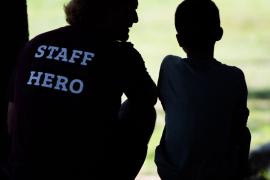“What am I supposed to do,” one camp director asked me, “with a mom who calls the camp every day of the session?” While such a wildly anxious mother may be rare (why did she send her child to camp if she can hardly bear his or her absence?), there is no question that, in general, camp parents are more anxious than in the past.
In a recent ACA webinar I hosted, which focused on the fears of parents, all the camp directors, program directors, and health personnel in (cyber) attendance reported that they were spending more time than ever before communicating with parents. They detailed making more efforts to anticipate parental concerns and to calm them by phone, blog, e-mail, and newsletters. However, despite adding many new layers of communication between camp and parents, and sometimes between children and parents, only a slim majority of camp personnel saw their efforts as resulting in lower levels of parental anxiety.
Many others experienced parents as being as worried as ever or growing more anxious, even with all the increased attention. Why are the efforts of residential camp directors to quell parental anxiety not working? Why is this generation of loving, conscientious parents so anxious about their children and, at a deeper level, about their own parenting? There are a large number of factors at work. Families are smaller, so moms and dads are less experienced than in the past; two children cannot provide their parents with the variety of temperaments and challenges provided by a family of four or five kids. Parents are nervous about global competition, school quality, and selective college admissions. Frightened that their children will not be economically as well off, they engage in what is called the “concerted cultivation” of their offspring in order to ensure their future success. Many parents are raising children with trauma theory in the back of their minds — feeling that preventing lifelong psychological harm to their kids from bullying or sexual abuse is their most important job. Finally, over the last thirty years, we have witnessed the decline of neighborhood play, so parents do not get the chance to watch their youngsters engaged in the natural flow and inevitable conflicts of children participating in free, undirected play.
Parents who do not trust their neighborhood streets are scheduling their children into adult-supervised activities, if they have the option to do so. Ninety percent of children in the U.S. participate in organized sports. Parents are increasing the amount of time they spend with their children; compared to twenty years ago, college-educated mothers have doubled the number of hours per week they spend with their children. Parents have more control over their kids and more information about them than they ever did before, starting with radio listening devices in the nursery to school-sponsored Internet programs that allow them to follow their children’s daily performance on homework and grades. Paradoxically, however, parents’ ability to monitor their children’s lives and the access to so much information about their kids results in the parents being more anxious rather than less anxious. I call these phenomena the “paradox of control” and the “paradox of information.”
The paradox of control can be stated simply: The more control you have over your child’s life, the less you trust your child’s development because you have less experience of his or her independence. Let us take walking to school as an example. Thirty years ago, almost 80 percent of children walked or biked to school. That figure has fallen to 13 percent, meaning that kids are always in the car commuting to school with their parents, and the parents are deprived of the opportunity to see that their children are capable of getting to school and home again on their own. More control for parents (“I feel my children are safer when I drive them to school in a car”) results in more uncertainty about the child’s developmental readiness (“When is he old enough to bike to school?”). The only way out of the trap of this paradox for parents is to allow their child to take moves toward independence. But having become accustomed to so much control, it is hard for a parent to let their child go.
The paradox of information is based on the assumption that the more a parent knows about his or her child’s life, the better that life will be. Is that a valid assumption? The reader can put it to the test with this question: If your mother had known twice as much about your days in school when you were in fifth grade or tenth grade, would your grades or friendships have been very different than they were? I think not. If your parents had been able to view daily pictures of you at summer camp, would that have added much to your camp experience? Of course not! But many parents think it does add value to their children’s experience for them to view the daily photos.
“Camp photos are a double-edged sword,” says Tom Holland, the director of Teton Valley Ranch Camp. “If I could reverse our decision to post camp photos every day, I would do so. Parents like them, but we have distressed parents who count the number of photos of their child and compare the number to that of their child’s friend. ‘There are eighteen photos of him,’ they complain, ‘and there are only twelve photos of my child.’” Tom continues, “If our Internet service is down — it is unreliable out here — we immediately get calls from four or five people who are sitting by their computers waiting for the 9:30 a.m. posting.”
Camp photos are a good example of the way in which camps, in an effort to allay parental anxiety, are actually feeding into the paradoxes of anxious parents. Photos on the Web site, the constant flow of gift packages, and the instant one-way delivery of e-mails from parent to child feed the parental delusion that they still have some control of their child’s life, and, furthermore, that they are receiving important, meaningful information about the child’s camp experience. (A small digression: It strikes me as patently unfair that parents get to be instantly in touch via e-mail, but kids still have to write letters. If campers write letters, parents should write letters.) What is lost is this fundamental truth that parents need to acknowledge: Sending a child to residential camp means temporarily giving up control of your child, and getting information, whether written or photographic, adds nothing to your child’s camp experience.
I have taken to telling parent audiences directly that seeing their children’s photos on the camp Web site adds absolutely no value whatsoever to the children’s time at camp, and that it can become something of an addiction to parents. They laugh self-consciously. I was proud of one mother from Hawaii who admitted that after courageously sending her child to a camp in the continental U.S. — a long plane flight — she obsessively looked at the camp photos every day. “Finally,” she admitted, “I realized the photos were all about me and had nothing to do with what he was doing at camp. The second year I made up my mind not to look at them and I felt much better.”
My work with parents in schools and with camp parents has persuaded me that parents fall roughly into two groups, which I call the “Ninety-Five Percenters” and the “Five Percenters.” Ninety-Five Percenter parents are, in spite of their anxiety, reasonable and workable. If you spend a little time with them on the phone, if you answer an e-mail or two, and especially if you give them some meaningful description of their child’s lived experiences at camp, they will calm down and trust you to look after their child. Five Percenters, on the other hand, cannot be calmed no matter what you do. For reasons of their own — whether those might be depression or anxiety disorder, substance abuse problems, unhappy marriages, their own sad history of sexual abuse, or even just being overprotective of their children — the reasonable decision to send a child to camp becomes a calamitous one for this kind of parent.
That is probably the case with the mother who calls the camp every day. Sooner rather than later, a camp director has to say to that mother, “What were you hoping for when you sent your child to camp?” Or, more bluntly, “Why did you send your child to camp?” Those questions need to be followed by additional questions that address the parent’s deepest fears: “If we don’t switch her cabin, what are you afraid will happen? Did something like that happen to you as a child?” What does not work is endless reassurance; indeed, reassurance can sometimes make an anxious person double down on their worries because he or she doesn’t think you really understand.
In the end, after you have politely let a parent know that you have talked more with him or her than you have with any other parent that summer (sometimes anxious parents assume all other parents are equally anxious), conversation with Five Percenters comes down to three questions: “Is there any way we are going to be able to reassure you?” or, “Is there any way we can gain your trust?” and finally, “It doesn’t feel as if you are ever going to be able to trust me or the personnel at this camp. Don’t you think you should drive up and take her home?” Tough words, but in the end, you cannot help every parent escape from the depths of their mistrust and worry.
Michael G. Thompson, PhD, is a psychologist and school and camp consultant. He is the author of Homesick and Happy: How Time Away from Parents Can Help a Child Grow (Ballantine Books, 2012).
Originally published in the 2013 January/February Camping Magazine


